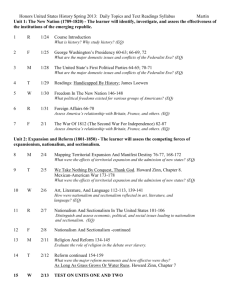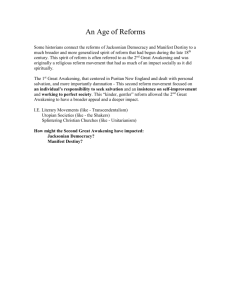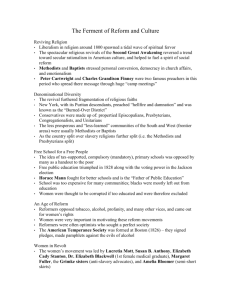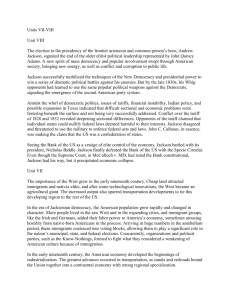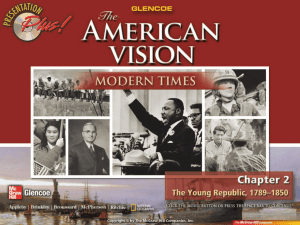Desired Results - Davidson County Schools
advertisement
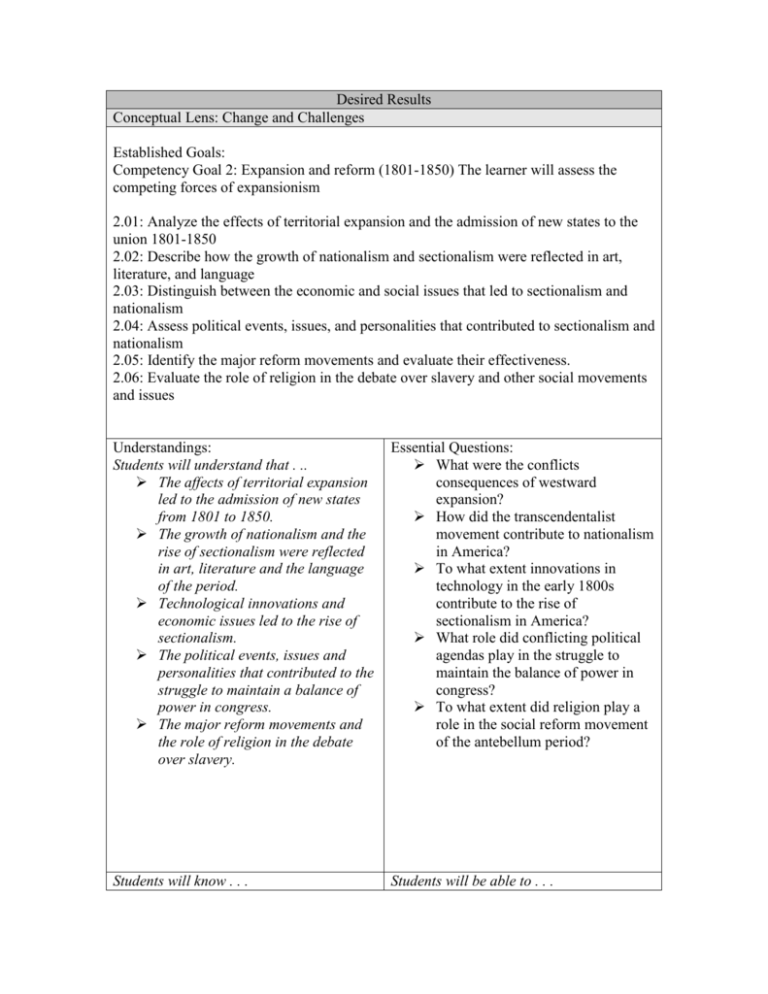
Desired Results Conceptual Lens: Change and Challenges Established Goals: Competency Goal 2: Expansion and reform (1801-1850) The learner will assess the competing forces of expansionism 2.01: Analyze the effects of territorial expansion and the admission of new states to the union 1801-1850 2.02: Describe how the growth of nationalism and sectionalism were reflected in art, literature, and language 2.03: Distinguish between the economic and social issues that led to sectionalism and nationalism 2.04: Assess political events, issues, and personalities that contributed to sectionalism and nationalism 2.05: Identify the major reform movements and evaluate their effectiveness. 2.06: Evaluate the role of religion in the debate over slavery and other social movements and issues Understandings: Students will understand that . .. The affects of territorial expansion led to the admission of new states from 1801 to 1850. The growth of nationalism and the rise of sectionalism were reflected in art, literature and the language of the period. Technological innovations and economic issues led to the rise of sectionalism. The political events, issues and personalities that contributed to the struggle to maintain a balance of power in congress. The major reform movements and the role of religion in the debate over slavery. Essential Questions: What were the conflicts consequences of westward expansion? How did the transcendentalist movement contribute to nationalism in America? To what extent innovations in technology in the early 1800s contribute to the rise of sectionalism in America? What role did conflicting political agendas play in the struggle to maintain the balance of power in congress? To what extent did religion play a role in the social reform movement of the antebellum period? Students will know . . . Students will be able to . . . The following terms and concepts: 2.01 Concepts The rationale for and the consequences of Manifest Destiny Federal Indian policy before The Civil War The political and economic importance of the West Terms Missouri Compromise The Indian Removal Act 1830 Sequoyah Worchester v. Georgia, 1832 Trail of Tears White man suffrage The Alamo Election of 1844 Texas Annexation “54-40 or Fight!” Mexican War Wilmot Proviso Treaty of Guadalupe-Hidalgo 49ers Stephen Austin Gadsden Purchase Lewis and Clark Oregon Trail 2.02 Concepts Cultural expressions of patriotism Celebrating the common man and the American way of life Influence of the Transcendentalist Movement Terms Noah Webster Ralph Waldo Emerson Henry David Thoreau 2.01 Analyze how manifest destiny motivated westward expansion and the opening of the west. Assess the validity of the following statement: American Indians presented a barrier to westward expansion that required military actions and political decisions. Identify and label a map of the new territories. Determine how the addition of new territories influenced economic and political change in the U.S. Identify how the Texas war for independence and subsequent annexation by the U.S. led to the war with Mexico. Relate to the plight of migrants moving west. 2.02 Explain transcendentalism and provide examples of two authors. Assess Noah Webster’s impact on literacy. Characterize the artistic movement known as the Hudson River School. 2.03 Identify how each of the following affected life in the early nation, cotton gin/telegraph/steel plow/mechanical reaper. Assess the role nativism played in the 2.04 Analyze how the expansion of democracy in the first half of the 19th century contributed to the rise of the common man. Identify the goals of Henry Clay’s American System. Discuss and chart the importance of Andrew Jackson’s administration. Identify the slave resistance movement. 2.05 Neoclassical Architecture Washington Irving Edgar Allen Poe Nathaniel Hawthorne James Fennimore Cooper Hudson River School of Artists Alex de Tocqueville 2.03 Concepts Transformation of life in the early industrial revolution Cultural polarization of Antebellum America Terms Samuel Morse Eli Whitney John Deere Cyrus McCormick Robert Fulton Erie Canal Cotton Kingdom 1st Industrial Revolution Nativism Know-Nothings William Lloyd Garrison Frederick Douglass 2.04 Concepts Political agendas of antebellum leaders Concepts of “Jacksonian Democracy” Slave Revolts States’ Rights Era of Good Feelings Complete a chart detailing leaders of the reform movement and their contributions. Compare and contrast the success of the different reforms of the period. Identity the goals of the early women’s movement and the impact of the Seneca Falls Convention. Define the term utopia and identify two successful utopian communities. 2.06 Discuss the impact of religion (Second Great Awakening) on the abolition movement. List the various ways abolitionist tried to end slavery. Terms Henry Clay American System Panic of 1819 McCulloch v. Maryland, 1819 Election of 1824 “corrupt bargain” suffrage spoils system Tariff of Abomination South Carolina Nullification Crisis South Carolina Exposition and Protest Election of 1832 Pet Banks Whig Party Election of 1840 Nat Turner’s Rebellion Monroe Doctrine 2.05 Concepts Women’s Rights Temperance Movement Improvement of social institutions (prisons, mental health, education) Development of Utopian Communities Terms Dorothea Dix Horace Mann Elizabeth Cady Stanton Lucretia Mott Seneca Falls Convention Sojourner Truth Susan B. Anthony Utopian Communities • Brook Farm Oneida New Harmony Rehabilitation Prison Reform 2.06 Concepts Second Great Awakening Moral Dilemma of Slavery The Abolitionist Movement Terms William Lloyd Garrison Grimke Sisters David Walker Frederick Douglass Charles G. Finney Assessment Evidence Performance Tasks: Other Evidence: Students will color code a map of Brainstorming activity to assess prior expansion. knowledge Students will complete a Rap/Poem of reformers and transcendentalists. Successful completion of review guide and Students will complete a chart of reformers graphic organizer. and transcendentalists Students will construct a chart of Multiple choice test innovations and their impact. Draw a political cartoon to illustrate an event, conflict, reform movement or personality discussed in the unit. Learning Plan Learning Activities: Day 1 a. Brain storming activity- to assess prior knowledge (War of 1812) b. Introduce visual – Manifest Destiny (art) and discuss c. Handout- Vocabulary and goal outline d. Teacher Notes on the Texas War and Mexican War e. Handout- Map of Westward Expansion Day 2 a. Review causes of Mexican War b. Teacher notes on the American System and rise of Nativism c. Handout-American System d. Students will read text and complete a chart of Industrial Innovations e. Introduce Andrew Jackson Day 3 a. b. c. d. Review industrial innovations Handout-Reading Guide on Jackson Teacher Notes on Jackson Handout- Graphic Organizer of Jackson Day 4 a. Trail of Tears (art) b. Handout-I Am Poem c. Video-Jackson Day 5 a. b. c. d. Day 6 a. b. c. d. Review the contributions of Introduce Transcendentalism Handout-Chart Reformers Handout- Reformer Raps: Assign groups- Each create a Rap/poem that reflect the ideas of the Reformer/Reform Movement assigned. Allow time to present Raps Teacher notes-Contribution of the Second Great Awakening Discuss impact on Abolitionist Movement and the Rise of Slave Resistance Video- Schlessinger – Expansion with viewing guide Day 7 a. Teacher led review b. Test on Expansion and Reform c. Students will draw a political cartoon describing an event, conflict, reform movement or personality discussed in the unit. Needed Resources: Overhead projector Media projector and VCR/DVD Schlessinger Video – Expansion with Study Guide A & E Biography of Andrew Jackson Graphic Organizer on Jackson Manifest Destiny (Artwork) Trail of Tears (Artwork) Map of Manifest Destiny Trail of Tears (Story) “I Am” poem Chart of Reformers (importance and contribution) Samples of Hudson River School Artists Excerpts from Irving and/or Cooper, Thoreau and Emerson Reading Guide for Goal 2 Outline of American System The Star Spangled Banner
